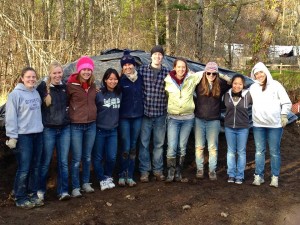We left the SUB on a cold, clear Saturday morning, and I sat like a zombie through the car ride, munching on my container of kefir and Uncle Sam cereal. This was to be my first Habitat for Humanity “build,” although technically there was no building involved, just a lot of hauling, dumping, shoveling, raking, wiping, painting, and washing. Since the build site is not just a house but a whole development (a “gated community without the gate,” as one future resident told me) there was ample work to be done for every stage of the process. Many of the tasks called to my mind and muscle memory the work that I did this last summer, picking up odd jobs all around the Tacoma area. It was fun to get back into the rhythm of manual labor, to be in a place for several hours with the sole intent of putting as much of my sweaty efforts into that development as I could. Well, I guess not the sole intent. Along with a sense of well-being, the other volunteers and I got paid in baked goods and good company. The homeowners who were working with us were very friendly and appreciative of our work, and the ones I met seemed happy with the process as a whole, even though it involves a big investment of time and work. There is time spent waiting to get approved, the time it takes to build a house, and 500 hours of work they are required to put in. Even though the housing is designed to be affordable, it is still out of reach for many. Nonetheless, it feels to me like a substitute for the old-fashioned helping one’s neighbor raise a barn. I’m told the world’s getting smaller, so it seems reasonable to help some neighbors who live a couple towns away.

Here’s a picture of some volunteers from the University of Puget Sound chapter, in front of our pet dirt pile that we were shoveling out to make nice, even lawns. There will also be a big park in the middle of all the houses – I like all the green space! Anyway, that’s one way to spend a Saturday morning and afternoon that will get you outside the college bubble, while still hanging out with some college friends.
